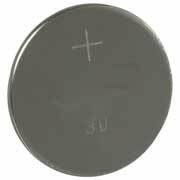
MONDAY, May 24 (HealthDay News) — The accidental swallowing of coin-sized lithium “button batteries” found in many common household products is a rapidly mounting threat to children, new research indicates.
In fact, a pair of new studies reveals that between 1985 and 2009 the risk that American children will experience a serious health complication after ingesting a button-battery has gone up nearly seven-fold.
“We’re talking about a really profoundly devastating injury, and sometimes fatalities,” said lead author for both studies Dr. Toby Litovitz, director of the National Capital Poison Center in Washington D.C. “But I think people are not aware of the problem, which is very, very much worse than swallowing a coin. And of course it’s hard for parents to protect their kids when they don’t realize that something is a problem.”
“It’s also clearly a worsening situation,” she added. “From the late 1970’s until now there have been 14 fatalities in the U.S. that we’re aware of, and of those 10 were just in the last six years. So that should send a signal of warning.”
Button batteries are found in remote controls, singing greeting cards, thermometers, DVD players and many other products to which children have ready access.
Litovitz explained that standard 20 millimeter lithium button batteries are thicker than a nickel and somewhere between a penny and a nickel in diameter. The batteries, she noted, have become very popular in recent years. Whereas in 1990 about 1 percent of all small 20 millimeter-sized batteries were lithium coin cells, now that figure has risen to about 18 percent to 20 percent.
The reason? “They are remarkable batteries,” said Litovitz. “They can pack in three volts, have a long shelf life, and they have more cold tolerance so they can be used in outdoor products. So they’re great, no question, and consumers don’t want to give them up.”
The problem, however, is that in the hands and mouths of children under four — who account for about 85 percent of accidental swallowing cases — an otherwise invaluable product can prove lethal.
Typically pediatric ingestion results in the battery getting lodged in the esophagus, the authors noted, rather than in air passages. So the risk is primarily not a question of choking, but rather one of a potentially fatal alkaline burn. The burns from lithium button batteries result not from battery leakage, but to exposure of body tissues to the battery’s external current, resulting in hydroxide that can burn through the throat or esophagus.
Litovitz and colleagues at George Washington University School of Medicine, the University of Virginia School of Medicine, and Georgetown University School of Medicine found that to prevent serious injury or death, a swallowed battery has to be removed from the child’s esophagus within two hours of swallowing.
The difficulty, said Litovitz, is that absent a choking incident a child who swallows a battery will probably not register any alarm, since “the child is not thinking it’s not a food item, and most are swallowing them like they’re swallowing a candy.” In addition, symptoms resemble those of the flu, including vomiting, fever, cough and lack of appetite.
Data compiled from the National Poison Data System and the National Battery Ingestion Hotline, as well as a review of more than 8,600 swallowing cases and an analysis of recent medical literature, collectively explained how such accidents happen.
In nearly 62 percent of cases, children under 6 are swallowing batteries they obtained directly from a consumer product. Nearly 30 percent find the batteries loose, while just over 8 percent get them from battery packaging.
“So to prevent accidents, the single most important thing is to put some burden on the consumer electronics industry that produces battery compartments that are way too easy to open,” stressed Litovitz. “And this is not just about toys. It’s the remote control, the watch, the calculator, the scale — typical household items. They need to be secured with a screw, and require a screwdriver to open them, so a child can’t get the battery out.”
“And parents need to be careful too,” she added. “They should store them where a child can’t get to them, and when they discard them make sure they’re out of reach. Parents can also go through the house and identify the products that have this lithium battery, and if the battery compartments aren’t secured they need to either tape it closed or put it out of reach. Basically, they need to find an intelligent solution.”
Dr. Lee Sanders, an associate professor of pediatrics at the University of Miami Miller School of Medicine, agreed that protecting children is a question of raising parental awareness while enlisting industry cooperation.
“There are many hidden hazards in homes today that parents do need to be aware of, particularly for children under age three who developmentally don’t have judgment as to what objects are dangerous,” he said.
“And certainly industry always has the responsibility to be mindful of what those hazards are,” Sanders added. “They must provide protection, so a young child can not easily open a product to get at the small lithium battery in the first place. And I would say to parents that while they need not be fearful of all this, they should be mindful.”
Litovitz and her colleagues present both studies in the June issue of Pediatrics.
More information
For more on child safety at home, visit KidsHealth.

